Brachytherapy for Breast Cancer treatment in Germany
Treatment prices are regulated by national law of the corresponding countries, but can also include additional hospital coefficients. In order to receive the individual cost calculation, please send us the request and medical records.
Breast Cancer Treatment in Germany
- Diagnostics
- Reconstruction with an expander or allo prosthesis
- Diep-flap plastic reconstruction with own tissues
- Reconstruction with own tissue or implant after radical mastectomy
- Radical mastectomy
- Chemotherapy
- Lumpectomy and lymphadenectomy by metastases to lymph nodes
- Radiotherapy
- Sectoral resection with flap plastic
- Proton Therapy
- Embolization or chemoembolization
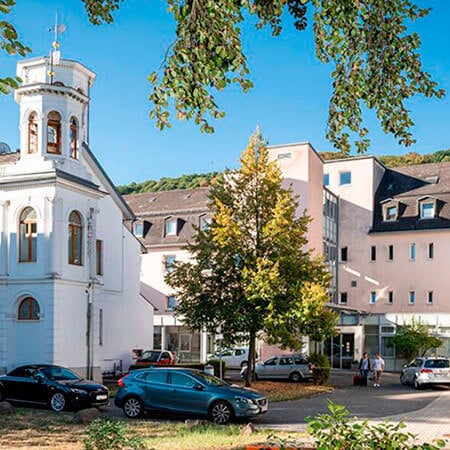
Department of Radiation Therapy and Radiation Oncology
The Department of Radiation Therapy and Radiation Oncology offers all types of modern radiation therapy for the highly effective treatment of benign and malignant tumors. The department is equipped with three linear accelerators and brachytherapy systems, which provide patients with the safest, most effective, and most sparing irradiation of tissues affected by oncopathology. The department also provides radiotherapy planning and radiosurgery. An ultramodern technical base, exceptional professionalism, and experience of the department's physicians are the cornerstones of successful clinical practice.
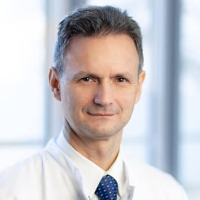


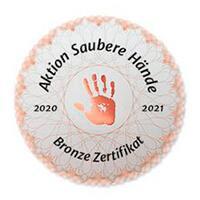
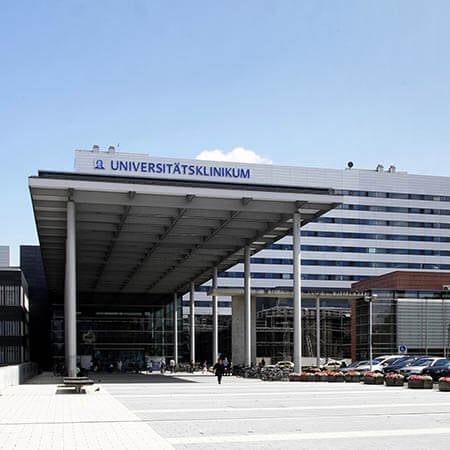
Department of Radiation Therapy
According to the Focus magazine, the Department of Radiation Therapy ranks among the top German medical facilities in the area of its specialization! The department offers all types of modern radiation therapy for cancer treatment at the highest level of university medicine. The priorities of the department's work include the treatment of tumors of the gastrointestinal tract, urogenital system in men, gynecological tumors in women, oncopathologies of the nervous system, as well as head and neck tumors. Each department's specialist strives to ensure all the patients with the most effective and at the same time customized treatment. Due attention is also paid to radiation protection.





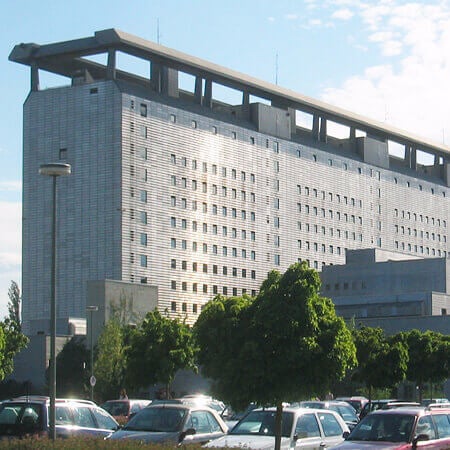
Department of Radiation Therapy
According to the Focus magazine, the University Hospital of Ludwig Maximilian University of Munich is regularly ranked among the best medical institutions in Germany! The hospital is the largest multidisciplinary medical facility, as well as a leading research and training center in Germany and Europe. The hospital is proud of its bicentenary history and tirelessly confirms its primacy at the national and international levels. The outstanding quality of medical care is complemented by highly productive research activities, thanks to which many effective diagnostic and therapeutic methods, saving people’s lives, have been presented in medical practice.
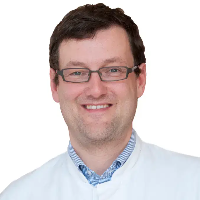





In recent years, more and more cases of breast cancer have been detected at an early stage in developed countries. This became possible due to the introduction of screening, i.e. an annual mass examination of an asymptomatic population. At the early stages of breast cancer, organ-preserving surgeries are performed. After them, breast radiation therapy is required. Brachytherapy can be used as one of the options for radiation therapy for breast cancer. It allows completing the breast irradiation course not in 6 weeks, as usual, but in just 5 days.
The essence of brachytherapy
Brachytherapy is a form of radiation therapy for breast cancer that includes placement of the radiation source as close to the tumor as possible. It is administered in the form of wires, balls, rods, but most often – in the form of microcapsules, which are also called grains, seeds, and granules.
Sometimes brachytherapy involves intense short-term exposure of tissues to radiation. This is called high-dose brachytherapy. The radiation source is introduced into the target area and quickly removed from it.
In other clinical situations, grains with a low dose of radiation are used. They work for a long time and may never be removed from the body at all. Over time, radiation weakens by itself. This is called low-dose brachytherapy.
Only high-dose brachytherapy is used to treat breast cancer. It can be used as an option for accelerated partial breast irradiation. This is a type of breast radiation therapy in which the radiation dose is delivered not to the entire breast, but only to the tumor bed after its surgical removal.
What types of brachytherapy are used for breast cancer treatment
By the way of radiation source introduction, brachytherapy is divided into the following types:
- Intracavitary
- Interstitial
- Application
- Intravascular
Intracavitary and interstitial brachytherapy are used for breast irradiation in German hospitals.
The intra-tissue (interstitial) brachytherapy is historically the first method of contact breast irradiation. It has a large evidence base. The essence of the method is that the doctor inserts thin tubes (i.e. catheters) into the tissues. The required dose of radiation is supplied through them according to the treatment scheme. The doctor connects plastic tubes to a special brachytherapy apparatus. With their help, radiation sources are introduced into the breast tissue and are removed after a short time.
The intra-tissue brachytherapy for breast cancer has a significant disadvantage – it requires an additional invasive procedure for the introduction of catheters into the mammary gland.
Intracavitary brachytherapy is increasingly being used for postoperative breast radiation therapy in German hospitals. It does not require additional tissue injury, which is a significant advantage for cancer patients. Immediately after surgery, the brachytherapy device is inserted into the former tumor bed. The brachytherapy device consists of a catheter with an inflatable balloon at the end. This balloon stays in the breast for several days. Twice a day, the doctor inserts radiation sources into it for a short time. After completing breast cancer treatment, the device is removed.
What is accelerated partial breast irradiation
Radiation therapy is an important part of breast cancer treatment. The problem is that it takes too long when performed in the standard fractionation mode. Women need about 30 sessions of breast radiation after its partial removal. She visits the radiation therapy center once a day, 5 days a week, during 6 weeks.
If you are undergoing treatment in Germany, the duration of each session will be short. Some devices allow breast irradiation in just 2 minutes. Together with the preparation, the procedure takes only about 15 minutes.
Nevertheless, women still must visit the clinic, interrupt her usual lifestyle, sometimes spending a long time abroad, and take a vacation at work. Many women lose their sources of financial income due to the need for additional breast cancer treatment after surgery.
In different countries, 30-70% of women refuse breast radiation therapy after breast cancer surgery, although they need it. They are afraid of losing their jobs or do not want to travel long distances daily from their place of residence to the hospital.
Therefore, in some cases, breast cancer treatment can be accelerated. The radiation is directed not at the entire breast, but only at a part of it, i.e. at the area where the doctor has recently removed the tumor. Women undergo only 10 sessions of radiation therapy for breast cancer. She visits the hospital 2 times a day. The entire course of partial radiation for breast cancer takes only 5 days.
The partial radiation therapy can be performed in different modes:
- Remote breast irradiation on high-precision linear accelerators, in 3D mode
- Intraoperative breast radiation therapy that is carried out immediately after partial removal of the breast, even before suturing the surgical wound
- Brachytherapy that includes the introduction of radiation sources into the breast tissue
Brachytherapy is one of the types of accelerated partial radiotherapy for breast cancer. It can only be used at the early stages, to irradiate the tumor bed, because it does not allow directing radiation to other areas of the body (such as the lymph nodes or chest wall).
Benefits of brachytherapy for breast cancer treatment
The main benefits of brachytherapy for breast cancer are as follows:
- Better distribution of radiation dose.
- Lower radiation load on the surrounding tissues. Radiation does not pass through them like with remote breast irradiation
- Safety. There are no adverse skin reactions after brachytherapy, and the risk of developing breast fibrosis is lower compared to the external radiation therapy.
- Ability to completely exclude the heart from the irradiation zone.
The efficacy of local disease control with brachytherapy is comparable with standard radiation therapy. Some studies show even better results. The study by the European Organization for Research and Treatment of Cancer (EORTC) demonstrated the benefits of brachytherapy in reducing the risk of recurrence after a breast cancer surgery. More than 2,500 women participated in it. After the external beam radiation therapy, breast cancer recurred in 4% of cases, while breast cancer recurrence after brachytherapy developed in 2.5% of cases.
In many countries, research is ongoing regarding additional brachytherapy options that are used in different clinical situations. The most promising techniques for making breast cancer treatment more sparing, faster and safer are:
- "Very" accelerated partial breast irradiation. Radiation is delivered during just 4 fractions, so the contact radiation therapy takes 2 days instead of usual 5 days.
- Brachytherapy after breast cancer recurrence. It allows repeating a breast-conserving surgery instead of mastectomy in case of local recurrence.
These breast irradiation modes in women with breast cancer are currently available in clinical investigations. Nevertheless, even standard approaches to brachytherapy have many benefits. Compared to the external beam radiation therapy, brachytherapy is preferred in:
- Deep localization of the tumor – over 28 mm from the skin surface
- Large breasts size – in this case women have a higher risk of fibrosis development due to the influence of radiation on a large tissue volume
- Non-aggressive types of breast cancer that rarely recur after surgery and radiation therapy
- Tumor size under 3 cm in the largest dimension, metastatic lesions of the lymph nodes are absent
Why is it worth undergoing treatment in Germany?
If you are undergoing treatment in Germany, you can expect that it will be carried out with the best results, minimal invasiveness, and with a high level of safety. Several reasons to undergo breast cancer treatment in Germany are listed below.
1. The precise diagnosis making. The precise examinations are the basis for the selection of ideal candidates for accelerated partial breast irradiation after breast conserving surgery. The stage of breast cancer is assessed, along with the location of the tumor, its shape, the size of the woman’s breast.
2. Better aesthetic results. Brachytherapy is an invasive procedure. If you are undergoing treatment in Germany, you can expect that it will be performed by specialists from German oncology clinics accurately and with minimal trauma. In German oncology centers, interstitial and intracavitary brachytherapy is performed. The intracavitary brachytherapy does not require additional invasive intervention on the mammary gland, as a catheter for the introduction of radiation sources is placed in the target area immediately after breast cancer surgery.
3. Combination with remote breast irradiation. Brachytherapy is not used for the irradiation of lymph nodes. Treatment in Germany, in some hospitals, provides patients with the possibility to combine external and contact radiation therapy for delivering radiation to all areas of the possible breast cancer recurrence.
4. Affordable prices. The cost of treatment in Germany is most likely to be higher than in your native country. Nevertheless, given the level of medical care, the ratio of quality and cost of treatment here is one of the best in the world.
Treatment in Germany with Booking Health
To undergo breast cancer treatment in Germany, you may use the Booking Health service. On the Booking Health portal you can find information about hospitals, doctors and prices for radiation therapy. In addition, you can compare the cost of treatment in different clinics and book a medical program at the best price. Booking Health will arrange your trip for treatment in Germany.
Services and benefits of the company include:
- Selection of an oncology clinic for the treatment of breast cancer in Germany, which specializes in brachytherapy
- Direct communication with the doctor from the radiation therapy department
- Reducing the waiting period for treatment in Germany and making an appointment at a convenient date
- Reducing the cost of treatment in Germany; prices are reduced due to avoiding coefficients for foreign patients
- Reliable information about your expenses, the cost of treatment and individual medical procedures, funds remaining in the account
- Elaboration of a treatment program in Germany without repeating previous studies
- Communication with the hospital after completion of treatment in Germany
- Purchase and shipping of drugs
- Organization of additional diagnostics or treatment in Germany
Booking Health specialists provide high-quality medical and related services. We will book hotel and airline tickets for you, organize a transfer from the airport to the hospital and back, provide you with a personal interpreter and translation of medical records.
Authors:
The article was edited by medical experts, board-certified doctors Dr. Nadezhda Ivanisova and Dr. Sergey Pashchenko. For the treatment of the conditions referred to in the article, you must consult a doctor; the information in the article is not intended for self-medication!
Sources:

